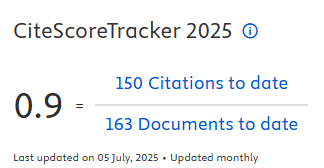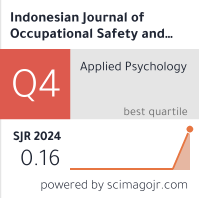Analysis of Context-Specific Mental Health Factors of Construction Workers in Indonesia

Downloads
Introduction: The construction industry is widely recognized as one of the sectors with significant mental health challenges. Many studies revealed that mental health problems such as depression, burnout, and sleep difficulty are more common in the construction industry compared to other industries. The causes may include high risk environment, long working hours, job insecurity, and machoism culture. On the other hand, the issue of mental health in the Indonesian construction sector is still not widely understood. Hence, this study investigates the key context-specific factors that influence the mental health of construction workers. Method: A mixed-method approach was employed, consisting of an integrative literature review (ILR) and exploratory factor analysis (EFA). The ILR identified twenty-three context-specific mental health factors, subsequently used as input in the questionnaire survey. The questionnaire consists of demographic characteristics and measurement of mental health factors using a six-point Likert scale. The survey was distributed to construction workers in Indonesia, each with a minimum of two years of work experience. The collected data were analyzed using EFA. Result: This study found five key groups of context-specific factors: workplace, work pressure, role, gender inequality, and psychosocial factors. These factors are found to be deeply interconnected, often exacerbating one another. The study underscores the complexity of mental health issues in this high-pressure, high-risk industry. The results suggest that addressing these challenges requires a multifaceted approach to better understand and alleviate the stress experienced by construction workers. Conclusion: This study presents five mental health determinants among construction workers in Indonesia. The findings can form the basis for further research and the formulation of work policies that are more responsive to local conditions.
Batubara, Z.Z.D.S., Safitri, A.R. and Siregar, S.D. (2021) ‘Faktor Kelelahan Kerja pada Pekerja Konstruksi di Proyek Gama Land’, Jurnal Kesehatan Global, 4(1), pp. 33–40.
Brockman, J.L. (2014) ‘Interpersonal Conflict in Construction: Cost, Cause, and Consequence’, Journal of Construction Engineering and Management, 140(2), p. 04013050.
Chan, A.P.C., Nwaogu, J.M. and Naslund, J.A. (2020) ‘Mental Ill-Health Risk Factors in the Construction Industry: Systematic Review’, Journal of Construction Engineering and Management, 146(3), p. 04020004.
Frimpong, S. et al. (2022) ‘Domains of Psychosocial Risk Factors Affecting Young Construction Workers: A Systematic Review’, Buildings, 12, p. 335.
Galea, N. et al. (2018) Demolishing Gender Structures. UNSW: Sydney.
Gruttadaro, D. and Beyer, C. (2021) Mental Health and Well-being in the Construction Industry: 2021 Pulse Survey. Washington: American Psychiatric Association Foundation Center for Workplace Mental Health.
Hansen, S. (2022) ‘Identifikasi Jenis Bahaya dan Parameter Penilaian Bahaya pada Pekerjaan Konstruksi’, PADURAKSA: Jurnal Teknik Sipil Universitas Warmadewa, 11(1), pp. 94–102. Available at: https://doi.org/10.22225/pd.11.1.4356.94-102.
Hansen, S. (2024a) ‘A Continuous Improvement Model for Indonesian Construction Workers’ Mental Health’, in N. Umeokafor et al. (eds) Handbook of Drivers of Continuous Improvement in Construction Health, Safety, and Wellbeing. Oxon: Routledge, pp. 43–56.
Hansen, S. (2024b) ‘Construction Workers’ Mental Health Factor Domains’, Media Komunikasi Teknik Sipil, 29(2), pp. 195–204. Available at: https://doi.org/10.14710/mkts.v29i2.57822.
Hansen, S. (2024c) ‘Tinjauan Pustaka sebagai Sebuah Metode Penelitian’, in Metodologi Penelitian Kuantitatif, Kualitatif & Mix Method. Yogyakarta: Balai Literasi Bangsa, pp. 192–218.
Hansen, S., Rostiyanti, S.F. and Septaria, D. (2024) ‘Negotiating Construction Change Order Claims’, Journal of Legal Affairs and Dispute Resolution in Engineering and Construction, 16(2). Available at: https://doi.org/10.1061/JLADAH.LADR-961.
Hon, C. (2021) ‘Improving Mental Health and Safety in the Construction Industry: A Study in Australia’, in Proceedings of the Joint CIB W099 and W123 Annual International Conference 2021: Good health, Changes and innovations for improved well-being in construction, pp. 109–117.
Hon, C.K.H. et al. (2024) ‘Psychosocial Hazards Affecting Mental Health in the Construction Industry: A Qualitative Study in Australia’, Engineering, Construction and Architectural Management, 31(8), pp. 3165–3192. Available at: https://doi.org/10.1108/ECAM-07-2022-0617.
Iremeka, F.U. et al. (2021) ‘Intervention for Stress Management among Skilled Construction Workers’, Medicine, 100(28), p. e26621. Available at: https://doi.org/10.1097/MD.0000000000026621.
Lingard, H., Turner, M. and Charlesworth, S. (2015) ‘Growing Pains: Work-life Impacts in Small-to-medium Sized Construction Firms’, Engineering, Construction and Architectural Management, 22(3), pp. 312–326. Available at: https://doi.org/10.1108/ECAM-07-2014-0100.
Liu, Q. et al. (2021) ‘Mental Health Issues in the Culturally Diverse Construction Workplace: A Literature Review’, in Proceedings of the 24th International Symposium on Advancement of Construction Management and Real Estate. Singapore: Springer Singapore, pp. 2229–2238. Available at: https://doi.org/10.1007/978-981-15-8892-1_156.
Liu, Q.J. et al. (2022) ‘Stressors in the Multicultural Construction Working Environment’, IOP Conference Series: Earth and Environmental Science, 1101(4), p. 042010. Available at: https://doi.org/10.1088/1755-1315/1101/4/042010.
Mollo, L.G. and Emuze, F. (2020) ‘The Well-Being of People in Construction’, In: Leal Filho W., Wall T., Azul A., Brandli L., Özuyar P. (eds) Good Health and Well-Being. Encyclopedia of the UN Sustainable Development Goals. Good Health and Well-Being”. Encyclopedia of the UN Sustainable Development Goals. Springer, Cham., pp. 1–10. Available at: https://doi.org/10.1007/978-3-319-69627-0_123-1.
Ness, K. (2012) ‘Constructing Masculinity in the Building Trades: “Most Jobs in the Construction Industry Can Be Done by Women”’, Gender, Work & Organization, 19(6), pp. 654–676. Available at: https://doi.org/10.1111/j.1468-0432.2010.00551.x.
Nurahma, A.P. et al. (2022) ‘The Relationship Between Mental Workload and Sleep Quantity with Work Fatigue among Haul Dump Truck Operators in Coal Mining’, The Indonesian Journal of Occupational Safety and Health, 11(3), pp. 333–342. Available at: https://doi.org/10.20473/ijosh.v11i3.2022.333-342.
Pratiwi, I. and Setyawan, R. (2024) ‘Assessment of Musculoskeletal Disorders in Brick Workers Using an Ergonomic Approach’, The Indonesian Journal of Occupational Safety and Health, 13(3), pp. 314–321. Available at: https://doi.org/10.20473/ijosh.v13i3.2024.314-321.
Rohayati, Y. et al. (2022) ‘Empowering Women HR in Construction Projects in Indonesia’, Budapest International Research and Critics Institute-Journal, 5(3), pp. 27125–27134.
Rostiyanti, S.F., Hansen, S. and Harison, S. (2020) ‘Understanding the Barriers to Women’s Career in Construction Industry: Indonesian Perspective’, International Journal of Construction Supply Chain Management, 10(4), pp. 267–283. Available at: https://doi.org/10.14424/ijcscm100420-267-283.
Scott-Young, C.M., Turner, M. and Holdsworth, S. (2020) ‘Male and Female Mental Health Differences in Built Environment Undergraduates’, Construction Management and Economics, 38(9), pp. 789–806. Available at: https://doi.org/10.1080/01446193.2020.1748213.
Sun, C. et al. (2022) ‘The Relationship between Psychosocial Hazards and Mental Health in the Construction Industry: A Meta-Analysis’, Safety Science, 145, p. 105485. Available at: https://doi.org/10.1016/j.ssci.2021.105485.
Sunindijo, R.Y. and Kamardeen, I. (2017) ‘Antecedents to Mental Health Symptoms in the Australian Construction Industry’, in P.W. Chan and C.J. Neilson (eds) Proceeding of the 33rd Annual ARCOM Conference. Cambridge: Association of Researchers in Construction Management, pp. 340–349.
Tennakoon, M. et al. (2023) ‘Comparative Study of Work-related Factors Affecting Mental Well-being of Male and Female Construction Workers in Australia’, in Y.G. Sandanayake et al. (eds) Proceedings of the 11th World Construction Symposium. Sri Lanka, pp. 344–354.
World Health Organization (2020) Constitution of the World Health Organization, Basic Documents, Forty-ninth Edition. Geneva: World Health Organization. https://apps.who.int/gb/bd/pdf_files/Bd_49th-en.pdf.

This work is licensed under a Creative Commons Attribution-NonCommercial-ShareAlike 4.0 International License.

In order to be accepted and published by The Indonesian Journal of Occupational Safety and Health, Author(s) who submit an article should complete all the review process. The copyright of received articles assigned to the The Indonesian Journal of Occupational Safety and Health and Department of Safety and Health, Universitas Airlangga as publishers of the journal. The intended copyright includes the rights to publish articles in various forms (including reprints).
The Editorial Team of The Indonesian Journal Of Occupational Safety and Health and Department of Safety and Health strive to ensure that no errors occur in the articles that have been published, both data errors and statements in the article.
Users of this website will be licensed to use materials from this website following the Creative Commons Attribution-NonCommercial-ShareAlike 4.0 International License. No fees charged. Please use the materials accordingly.
------------------------------------------------------------------------------------------------------------------------------------------------------------------------------------------
Attribution ” You must give appropriate credit, provide a link to the license, and indicate if changes were made. You may do so in any reasonable manner, but not in any way that suggests the licensor endorses you or your use.
NonCommercial ” You may not use the material for commercial purposes.
ShareAlike ” If you remix, transform, or build upon the material, you must distribute your contributions under the same license as the original.







 How to Submit Articles in OJS
How to Submit Articles in OJS

























